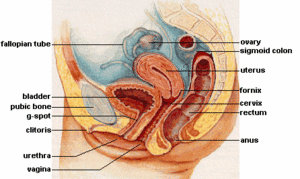Vagina
|
|
The vagina (from the Latin for "sheath" or "scabbard" ) is the tubular tract leading from the uterus to the exterior of the body in female mammals, or to the cloaca in female birds and some reptiles. Female insects and other invertebrates also have a vagina, which is the terminal part of the oviduct.
For the purposes of anatomy, a vagina can also be any structure that serves as a sheath (or theca), as in, the vagina of the portal vein. Another example is the fibrous sheath around tendons, called a vagina fibrosa when solid or a vagina mucosa when it contains a fluid-filled cavity around the tendon.
Human vaginas
The vagina is an elastic muscular tube about 4 inches (100 mm) long and 1 inch (25 mm) in diameter that connects the vulva at the outside to the cervix of the uterus at the inside. If the woman stands upright, the vaginal tube points in an upward-backward direction and forms an angle of slightly more than 90 degrees with the uterus. The vaginal opening is at the back (caudal) end of the vulva, behind the opening of the urethra. Above the vagina is Mons Veneris .The inside of the vagina is usually pink, as with all internal mucous membranes in mammals.

